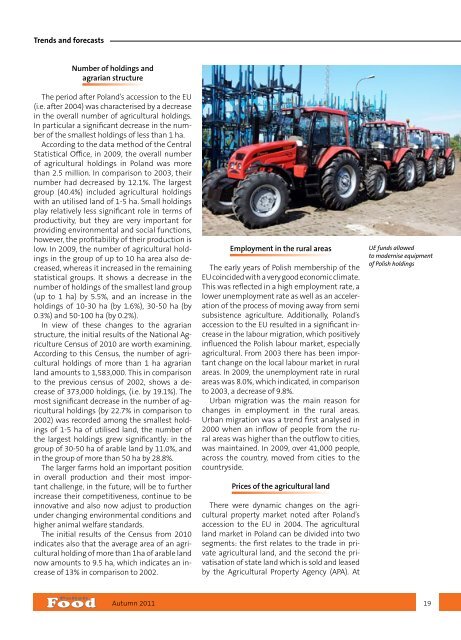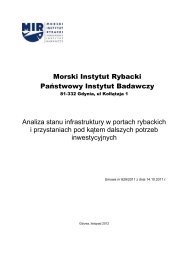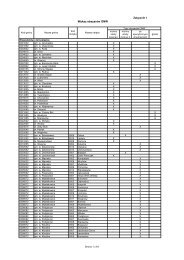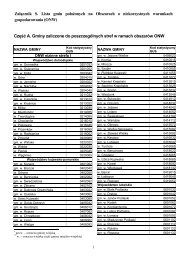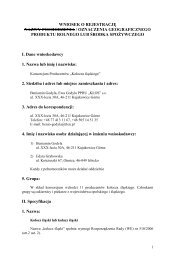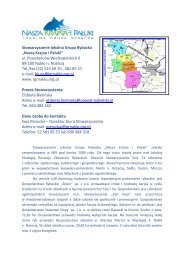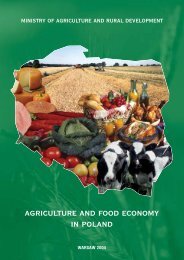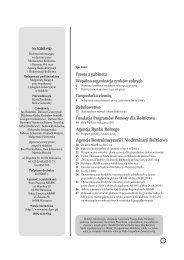download file
download file
download file
You also want an ePaper? Increase the reach of your titles
YUMPU automatically turns print PDFs into web optimized ePapers that Google loves.
Trends and forecasts<br />
Number of holdings and<br />
agrarian structure<br />
The period after Poland’s accession to the EU<br />
(i.e. after 2004) was characterised by a decrease<br />
in the overall number of agricultural holdings.<br />
In particular a significant decrease in the number<br />
of the smallest holdings of less than 1 ha.<br />
According to the data method of the Central<br />
Statistical Office, in 2009, the overall number<br />
of agricultural holdings in Poland was more<br />
than 2.5 million. In comparison to 2003, their<br />
number had decreased by 12.1%. The largest<br />
group (40.4%) included agricultural holdings<br />
with an utilised land of 1-5 ha. Small holdings<br />
play relatively less significant role in terms of<br />
productivity, but they are very important for<br />
providing environmental and social functions,<br />
however, the profitability of their production is<br />
low. In 2009, the number of agricultural holdings<br />
in the group of up to 10 ha area also decreased,<br />
whereas it increased in the remaining<br />
statistical groups. It shows a decrease in the<br />
number of holdings of the smallest land group<br />
(up to 1 ha) by 5.5%, and an increase in the<br />
holdings of 10-30 ha (by 1.6%), 30-50 ha (by<br />
0.3%) and 50-100 ha (by 0.2%).<br />
In view of these changes to the agrarian<br />
structure, the initial results of the National Agriculture<br />
Census of 2010 are worth examining.<br />
According to this Census, the number of agricultural<br />
holdings of more than 1 ha agrarian<br />
land amounts to 1,583,000. This in comparison<br />
to the previous census of 2002, shows a decrease<br />
of 373,000 holdings, (i.e. by 19.1%). The<br />
most significant decrease in the number of agricultural<br />
holdings (by 22.7% in comparison to<br />
2002) was recorded among the smallest holdings<br />
of 1-5 ha of utilised land, the number of<br />
the largest holdings grew significantly: in the<br />
group of 30-50 ha of arable land by 11.0%, and<br />
in the group of more than 50 ha by 28.8%.<br />
The larger farms hold an important position<br />
in overall production and their most important<br />
challenge, in the future, will be to further<br />
increase their competitiveness, continue to be<br />
innovative and also now adjust to production<br />
under changing environmental conditions and<br />
higher animal welfare standards.<br />
The initial results of the Census from 2010<br />
indicates also that the average area of an agricultural<br />
holding of more than 1ha of arable land<br />
now amounts to 9.5 ha, which indicates an increase<br />
of 13% in comparison to 2002.<br />
Employment in the rural areas<br />
The early years of Polish membership of the<br />
EU coincided with a very good economic climate.<br />
This was reflected in a high employment rate, a<br />
lower unemployment rate as well as an acceleration<br />
of the process of moving away from semi<br />
subsistence agriculture. Additionally, Poland’s<br />
accession to the EU resulted in a significant increase<br />
in the labour migration, which positively<br />
influenced the Polish labour market, especially<br />
agricultural. From 2003 there has been important<br />
change on the local labour market in rural<br />
areas. In 2009, the unemployment rate in rural<br />
areas was 8.0%, which indicated, in comparison<br />
to 2003, a decrease of 9.8%.<br />
Urban migration was the main reason for<br />
changes in employment in the rural areas.<br />
Urban migration was a trend first analysed in<br />
2000 when an inflow of people from the rural<br />
areas was higher than the outflow to cities,<br />
was maintained. In 2009, over 41,000 people,<br />
across the country, moved from cities to the<br />
countryside.<br />
Prices of the agricultural land<br />
There were dynamic changes on the agricultural<br />
property market noted after Poland’s<br />
accession to the EU in 2004. The agricultural<br />
land market in Poland can be divided into two<br />
segments: the first relates to the trade in private<br />
agricultural land, and the second the privatisation<br />
of state land which is sold and leased<br />
by the Agricultural Property Agency (APA). At<br />
UE funds allowed<br />
to modernise equipment<br />
of Polish holdings<br />
Autumn 2011 19


